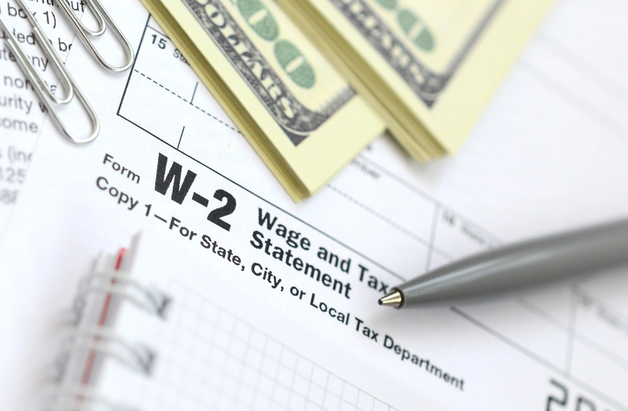How to Calculate W-2 Wages From a Pay Stub

September 27, 2023
Understanding how to calculate W-2 wages from a pay stub is vital to planning how to pay your taxes and avoid incurring penalties through late or insufficient tax payments.
At the same time, having a solid background on the essential information to look for when determining your W-2 wages clarifies common tax withholding and payroll-related queries, such as:
- Why is my W-2 wage higher than my salary?
- Why does my final pay stub look different from my W-2 form?
So, to get answers to these questions and learn how to calculate your W-2 wages from your pay stub, make sure to read the full article.
Let’s start!
Key Takeaways
- A pay stub contains an employee’s gross and net earnings, deductions, and withholding taxes. A W-2 form is an IRS tax form used by employees to file their taxes.
- Employers also use Form W-2 to report all employee wages and salaries paid within the year.
- The key information needed to calculate W-2 wages from a pay stub includes gross income, non-taxable income, pre-tax deductions, federal, state, and local taxes, and Social Security and Medicare taxes.
The Difference Between a W-2 Form and a Pay Stub
There are key differences between a W-2 form and a pay stub. Knowing how the two documents differ is crucial to learning how to calculate W-2 wages from your pay stub.
What is a Pay Stub?
A pay stub is a document issued by employers to each of their employees every payday. The pay stub enumerates an employee’s gross and net wages, including the taxes, retirement and insurance contributions, and other adjustments applied to their earnings.
An employee’s gross and net pay are determined by their hourly rates multiplied by the number of hours worked.
It is essential to point out that a regular pay stub is different from a final pay stub. The final pay stub refers to the check stubs that employees receive at the end of the year or during tax season.
Also called end-of-year pay stubs, final pay stubs specify the total gross wages or earnings of each employee. Final pay stubs also include non-taxable income or expenses, which increase the gross wages but decrease the total taxable income on Form W-2.
What is a W2 Form?
A W-2 Form, or more formally called the Form W-2, Wage and Tax Statement, is an IRS form that employers are required to file for each of their workers.
The said tax form specifies all key information related to an employee’s income, withheld taxes, and benefits throughout the calendar year. Employees need their W-2 forms to file their federal and state taxes come tax season.
Employers also use Form W-2 to report all employee wages and salaries to the IRS. Independent contractors and self-employed individuals use different tax forms to file their tax returns.
One of the most noticeable differences between a W-2 form and a pay stub is the total wages or earnings declared in each form. Compared to the values enumerated on the final pay stub, W-2 forms take into account the total taxable earnings.
At the same time, some contributions, such as 401(k) and other employer-sponsored retirement plans, only reduce the federal and state taxes that an employee owes.
In contrast, pre-tax health and life insurance deductions reduce taxable income and increase an employee’s take-home pay.
As such, if an employer offers pre-tax-deducted health insurance to their workers, then the taxable wages on Boxes 1, 3, and 5 of the employee’s W-2 form will be noticeably reduced.
6 Steps on How to Calculate W-2 Wages From a Pay Stub

The following are the six different steps in calculating W-2 wages using your pay stub as a basis:
Step #1. Calculate Your Gross Income
The first step is to know and understand how to calculate gross income from a pay stub. Gross income is your total earnings within a completed pay period or cycle before taxes are withheld.
To get the gross income amount, multiply your hourly or pay rate by the total number of hours worked.
For example, if you are paid a fixed hourly rate of $35 and complete 80 work hours for a biweekly pay cycle, then you must yield the following results:
$35 X 80 = $2800 is your total gross income.
If you also received bonuses, tips, or overtime compensation, then include the amounts in your total gross pay.
Step #2. Identify Other Deductions
Next, if you elected to receive employer-sponsored benefits that are pre-tax deducted, such as health and life premiums or transportation allowance, then combine all the additional deductions and subtract the sum from your gross income.
Step #3. Remove Non-Taxable Income
Non-taxable income is a type of compensation given to employees that is not necessarily subject to federal or state taxation.
It may be any of the following:
- Child support
- Dental insurance
- Eye care
- Corporate partnership earnings
- Financial rewards or gifts
- Disability insurance
- Scholarships and grants
Get the sum of all the non-taxable income you received and deduct the total amount from your gross income.
Step #4. Calculate Your Annual Taxes
The key part of understanding how to calculate W-2 wages from your pay stub is to account for your taxes.
On your pay stub, take down all the federal, state, and/or local taxes withheld from your income. Combine all the values, and then multiply the result by the number of pay periods or how frequently you were paid in a year.
If your employer pays you biweekly, then multiply your annual taxes by 26, 24 if you are paid semi-monthly, and 12 if you are paid monthly.
It is also important to know how to calculate Social Security wages on your W-2 form, as well as how to calculate Medicare wages.
To calculate your social security wages, multiply your gross income by 6.2%.
Using the example from the first step and assuming there are no overtime pay, salary increases, or unpaid leaves to add or subtract from your gross income, your social security wage should be as follows:
- $2800 X 6.2% = 173.6
To calculate your Medicare wages, multiply your gross earnings by 1.45%:
- $2800 X 1.45% = 40.6
Since Social Security and Medicare taxes are split between employers and employees, you can determine the amount withheld from your earnings for both your share and your employer’s share by multiplying your Social Security and Medicare wages by 2.
- 173.6 X 2 = 347.2 (The amount of Social Security taxes paid by you and your employer)
- 40.6 X 2 = 81.2 (The amount of Medicare taxes paid by you and your employer)
Step #5. - Calculate Your Total W2 Earnings
Once you have subtracted all non-taxable income and pre-tax deductions from your gross earnings, subtract your total annual taxes from your resulting gross pay.
The resulting value is your total W-2 earnings.
Step #6. - Keep in Mind the Tax Season
Now that you’ve gained the knowledge of how to calculate W-2 wages from your pay stub, you can make your calculations and tax estimations ahead of time. In fact, you can determine your W-2 wages before the tax season.
In doing so, you can assess the necessary preparations to make to ensure you fulfill your tax obligations in a timely manner. More importantly, you can double-check whether you qualify for a refund or not.
How Pay Stubs Help With Calculating W-2 Wages

Pay stubs help with calculating W-2 wages by providing essential information about your gross salary, the amount of taxes withheld, and the types of deductions subtracted from your earnings.
As such, by calculating your W-2 wages using your pay stub, you can deduce your taxable income and estimate your tax liabilities for the year. Determining how much tax you potentially owe the government allows you to make prior preparations to help you avoid paying insufficient taxes.
You can also use your calculated W-2 wages as a basis and consult with your employer to adjust the amount withheld for your deductions. This is a good option if you want to increase your retirement and insurance contributions or intend to have all your taxes paid on or before the due date.
Additionally, your pay stubs specify your hourly rates, the number of work hours you’ve completed in a payroll cycle, overtime pay, and any adjustments or increases applied to your salary.
The said values allow you to double-check whether you are compensated accordingly and if the withheld tax amounts adhere to your filing status and tax bracket and remain proportionate to your gross income.
What Information is Needed From Pay Stubs to Calculate W-2 Wages?
To calculate W-2 wages from your pay stub, you’ll need the following information from your pay slip:
- Gross income. The first detail you must look for in your pay stub is your gross income. Your gross income is the total income you earn in a pay period before taxes and deductions are imposed on your earnings. You can find your gross at the bottom of all your itemized earnings, bonuses, overtime pay, and commissions.
- Non-taxable payments. Identifying your non-taxable payments keeps you from miscalculating your taxes. Non-taxable payments or non-taxable income refer to any property or monetary payments that are not subject to any federal, state, or local taxation. Examples of non-taxable payments, according to the IRS, include monetary gifts, disability wages, child support, inheritance, alimony, financial aid income, and cash rebates. Take note of any non-taxable income in your pay stub and exclude it from your taxable earnings.
- Other deductions. This particular information includes your 401(k) or other employer-sponsored retirement accounts, health insurance, employer benefits, and transportation allowance. The aforementioned deductions reduce your taxable income.
- Federal taxes. Federal taxes are the taxes you pay to the IRS. Your filing status, tax bracket, and number of dependents are some of the factors that determine the amount withheld from your income for your federal tax payments.
- Social Security and Medicare. Social Security and Medicare tax contributions are split between employees and employers. You share a 6.2% tax rate with your employer for Social Security taxes and 1.45% for Medicare. You can find your Social Security and Medicare tax withholdings enumerated under ‘Deductions’ on your pay stub.
- State and local taxes. State and local tax rates will depend on whether your state or local government levies taxes on your income.
Final Thoughts
In truth, the steps involved in calculating W-2 wages from your pay stub are quite simple. All that matters is that you know which values to look for in your paycheck or pay slip and subtract or add the correct numbers.
On the other hand, if the steps described in this article prove too tedious a job for you to do, you can always rely on an online pay stub generator to do all the gross pay, withholding tax, and net income math for you.
How to Calculate W2 Wages From a Pay Stub FAQ
#1. What are W-2 wages?
W-2 wages are earnings or wages that are subject to federal income taxation. W-2 wages may also include other forms of payment made by an employer to employees throughout the latter’s tenure in the company.
#2. How do I find gross income on my pay stub?
To find your gross income on your pay stub, look below your hours and regular rate. Your gross income reflects the sum of the hours you have worked in a pay period multiplied by your regular or hourly rate, including all additional benefits, bonuses, and overtime pay.
Note that social security wages are not the same as gross income and are therefore not included in calculating your gross earnings.
#3. Why should I calculate W-2 wages from a pay stub?
You should calculate W-2 wages from a pay stub because the resulting values give you a clear idea of the amount of taxes withheld from your regular income. At the same time, your W-2 wages declare your annual net income.
#4. Why does my W-2 form look different than my last pay stub?
Your W-2 form looks different than your last pay stub because your Form W-2 reports all your taxable wages within the year once all pre-tax deductions are applied. Pre-tax deductions include healthcare insurance plans, life, dental, and disability insurance, and retirement contributions.


